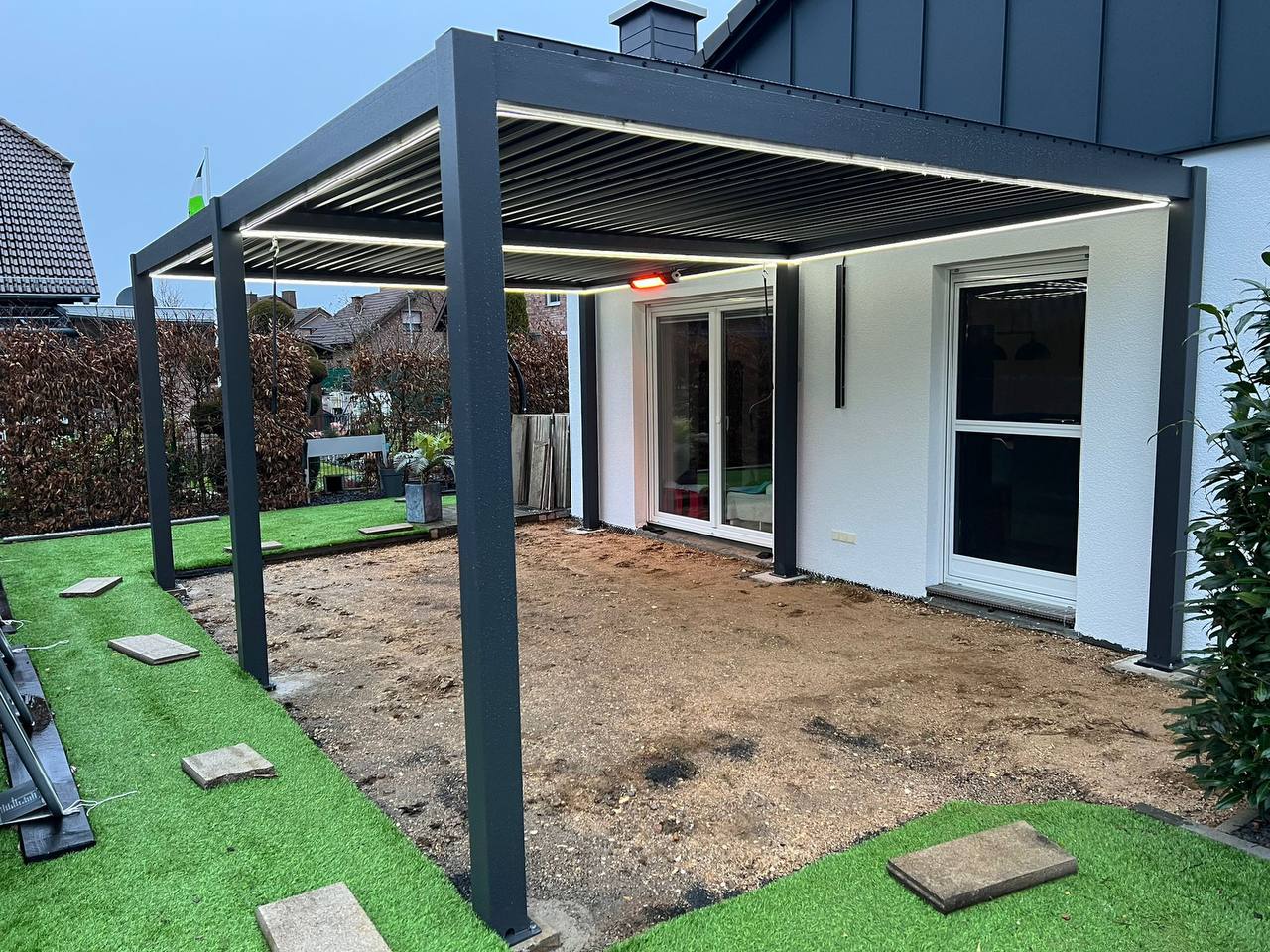How to make your Pergola Foundation

To be on the safe side, a pergola needs a stable foundation. In this blog you can find out what types there are and which one is the right one for your PERGOLUX Pergola.
Why is a good foundation important?
A correct foundation provides a stable, level base for your pergola. This not only makes assembly easier but also ensures the required stability of the pergola. If you install your pergola on a sloping ground, it will be subjected to an unbalanced pressure that it was not designed to withstand.
This may have consequences:
- The pressure on the screw connections is too high, it can cause damage.
- The integrated gradient may be negatively influenced, so the water cannot drain properly.
- Accessories such as screen blinds cannot be installed correctly.
It also has disadvantages in terms of looks - who wants to have a crooked pergola?
Is a foundation mandatory?
Pergolas are available in different sizes and weight classes, it is often not clear whether a foundation is absolutely necessary or whether, for example, a compacted soil with a layer of gravel and terrace slabs lying on it is sufficient. In any case, it is advisable to know the building regulations that apply to the planned construction site of the pergola.
- Building regulations: You do not need a building permit, however, there are a few things to consider and can be found in the article: Do I Need Planning Permission For My PERGOLUX Pergola?
- Club statutes: in allotment garden clubs there are also precise regulations for foundation construction. Even if you can't find anything about it in the lease and articles of association, you should contact the board and ask to be on the safe side!
In some cases a foundation is not necessary. This would be the case if you have already built your terrace on a foundation and can thus ensure optimal attachment of the pergola, for example with anchor bolts (expansion bolts).
Plan the foundation
Check the subsoil
The condition of the subsoil plays an extremely important role and should be checked first. Is it pure, solid topsoil or loose, sandy soil? Is the subsoil possibly crisscrossed with roots that make it difficult to build the foundation?
To do this, simply do a test excavation to be sure!
Supply lines
Do you perhaps need power and water connections in your pergola for an outdoor kitchen, light or heating, for example?
- The empty pipes required for this should already be integrated during the construction of the foundation. Except for point and strip foundations, they can be retrofitted.
- Consider whether you do this work yourself or whether you need to hire specialists.
Size
For concrete planning of the foundation, refer to the dimensions in the floor plan of your future PERGOLUX Pergola. In addition, it is possible to receive a foundation plan for the respective model in advance. In this way you can prepare the foundation in advance and do not have to store the pergola for a long time.
Foundation type
Depending on the given conditions, different foundation variants are possible.
- A slab foundation made of path slabs is often sufficient for small pergolas
- For larger models, there should be point or strip foundations
- On unstable ground, a continuously closed concrete slab is recommended
- If the ground is stable, the screw foundation, which can be built relatively quickly, is an option
Different Types of Foundations
The foundation of paving slabs
A foundation made of path plates is the simplest variant. It can be built with little effort and is sufficient for small pergolas.

Paving tiles are available in different sizes, eg 30x30, 40x40 or 50x50 cm, they are several centimeters thick. However, they cannot withstand large selective loads, they would simply break through. To ensure that the slabs are stable and straight, a deep pit must first be dug, 30 cm should be enough here. This pit is then to be filled with one layer of crushed stone and one with gravel. The individual layers should first be compacted, only then do the paving stones follow. The last step is filling with sand so that the joints between the panels are tight.
- Advantage: built quickly, relatively low costs
- Disadvantage: only suitable for lighter pergolas
The strip foundation
The strip foundation is so called because only about 40cm wide concrete strips are poured onto which the pergola can be attached. Properly built, it is sufficient for the largest pergola models, but requires an enormous amount of effort.

So that the strip foundation is also frost-proof, the trenches must have a depth of at least 80 cm. A mini excavator would be very helpful here! To prevent the trench walls from collapsing, it is helpful to use formwork boards to support them before the trenches are poured with concrete.
If the subsoil is not stable enough, we recommend installing an additional 10 cm thick concrete slab - on compacted gravel and a PE foil.
- Advantage: very stable, frost-proof, relatively little concrete is required without a slab
- Disadvantage: an enormous amount of work, construction machinery necessary
The concrete slab foundation
A closed concrete slab forms an absolutely stable base for the pergola. However, the construction is quite labor-intensive and associated with high costs. This variant is only really necessary for unstable, loose soil or in swampy terrain near water.

This type of foundation is also sometimes chosen where it is not absolutely necessary because the construction seems simpler than a strip or spot foundation. However, very large quantities of fresh concrete are required here, which you do not want to mix yourself.
Before you can pour this foundation, preliminary work is necessary. First, a 40-50cm deep pit must be dug in the dimensions of the pergola - with some allowance for the boarding. The ground must be straightened and compacted. The walls have to be supported with sturdy formwork boards, since several tons of weight are involved here.
This is followed by a 15cm thick layer of gravel, which must also be straightened and compacted. A vibrating plate is essential here.
A thick PE film then follows the gravel to protect the concrete from below against moisture.
Only after these steps can the fresh concrete be poured. The concrete is applied in two layers. Steel mats (reinforcement) are placed between the layers for stabilization. Finally, the concrete is pulled smooth with the squeegee.
- Advantage: maximum stability, very useful on unstable ground
- Disadvantage: Enormous amount of work, very high costs, construction machinery absolutely necessary
The point foundation
A point foundation requires significantly less concrete than a concrete slab or a strip foundation. It consists of several "punctiform" individual foundations that are erected under the columns of the pergola at regular intervals.

You save a lot of material here, but this variant is only suitable on solid, load-bearing soil. If the soil is too loose, the weight of the pergola may shift them as they are not connected.
Although one saves on material, great accuracy is required when measuring, digging out and boarding the individual foundations. Shuttering the individual foundations with shuttering boards is an effort that should not be underestimated. As a small "do it yourself tip" at this point, the use of stable pipes with correspondingly large diameters should be used as casing. Once everything has been prepared, fresh concrete is poured into the formwork or the pipes. The amount of concrete that is required can still be managed with ready-to-mix concrete from the hardware store.
- Advantage: comparatively little material, therefore correspondingly lower costs
- Disadvantage: not possible on loose ground, very high accuracy required when measuring.
Now we have explained the different variants of the foundations. But what type of foundation is suitable for a pergola with a slat roof?
Our recommendation for the PERGOLUX Pergola
In order to achieve the maximum wind load, we recommend using reinforced point foundations measuring 85x85x85cm and connecting them with a strip foundation. The pergola can then be fixed to the foundation through the decking with so-called anchor bolts (expansion bolts).
Alternatively, the pergola can also be screwed onto smaller-sized point foundations such as 40x40x75cm or directly into terrace coverings such as stone slabs or wooden floorboards. A lot of customers do that too and the maximum wind load is somewhat dependent on your circumstances.
3x3m PERGOLUX Pergola

3x4m PERGOLUX Pergola

4x4m PERGOLUX Pergola

4x6m PERGOLUX Pergola

Customer's photos of their pergola foundation:





